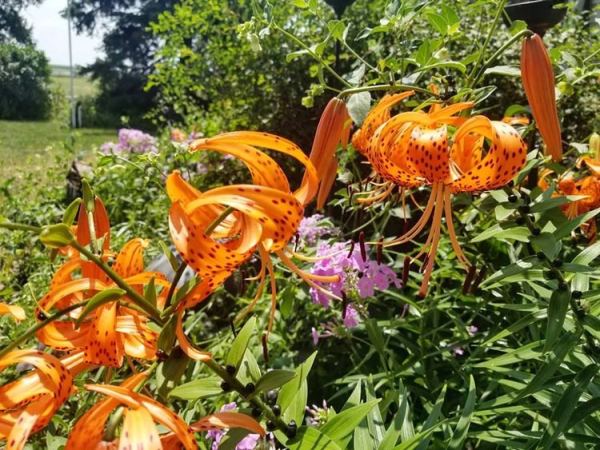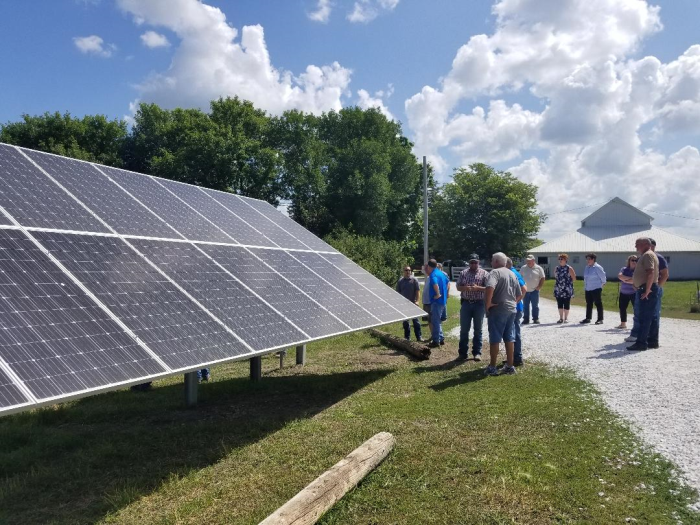Farm Life Journal - August 2018
August 6, 2018
By Darcy Dougherty Maulsby
Greetings from Calhoun County!
 It’s sweet corn time, and boy do we have a great crop this year. Corn pollination season must have gone well because there are kernels all the way to the tip on each ear. That doesn’t happen if Mother Nature causes any snags during the pollination process.
It’s sweet corn time, and boy do we have a great crop this year. Corn pollination season must have gone well because there are kernels all the way to the tip on each ear. That doesn’t happen if Mother Nature causes any snags during the pollination process.
We tend to eat fresh sweet corn off the cob, although we do freeze some. I also have recipes for everything from sweet corn soup to sweet corn cake. I’ve shared one of my favorite recipes below for a great side dish if you want to pair bacon with sweet corn for a creamed corn dish you’ll want to prepare year-round.
Not only is our corn (both sweet corn and field corn) looking good, but so are our soybeans. If you’ve heard about the trade wars between the U.S. and China, you know the tariffs have been affecting U.S. soybeans. China’s unfair trading practices are something that need to be addressed.
After all, soybeans are big in Iowa. Did you know that August is designated as soybean month here in Iowa? Here are a few quick facts from the Iowa Soybean Association:
- Iowa ranks No. 2 nationally in soybean production.
- Nearly 1 out of every 3 acres of U.S. soybeans is exported to China.
- China is an important, growing market for Iowa soybeans and helps feed the Asian nation’s 1.4 billion people.
- Nearly 42,000 Iowa farmers grow soybeans.
- The average Iowa soybean farmer grows enough grain each year to feed 60,000 people.
- Every pig raised in Iowa consumes nearly 3 bushels of Iowa-grown soybeans, making hogs the soybean farmers’ No. 1 domestic customer.
- The value of Iowa’s soybean crop exceeds $5 billion.

Lilies Connect the Past and Future
Sweet corn and soybeans aren’t the only plants in their prime on our farm. The tiger lilies in the garden at my family's Century Farm have bloomed every summer for decades. I think they were planted by my Grandma Katherine, although they may go back further in our family history.
You sometimes see tiger lilies like these in the ditch, a clue that a farmhouse once stood nearby. Since they transplant fairly easily, I transplanted them when we lived at our acreage near Granger, and I'm going to transplant some to our current home in the country. More than just a flower, these lilies are a link between the past and the future.
Conservation and Continuous Improvement
This connection between the past and the future motivates my family to maintain the land we care for and find new solutions that help us do an even better job. I’m also excited to see how conservation on the farm takes so many innovative forms here in Calhoun County. I’m president of the Calhoun County Corn Growers and was happy to help organize a conservation field day with my neighbors on July 31.

It was great to see more than 40 people, from farmers to bankers, stop by the field day. On my neighbor Mark Schleisman's farm west of Lake City, we learned about cover crops in a row-crop and cattle operation. Then we headed east of Lake City to my friend Dwight Dial’s farm to talk more about soil health, cover crops and soil organic matter. Farmers like Dwight are finding out that cover crops not only enrich the soil, but they can help control weeds.
I’m inspired to see so many farmers trying to find better ways to focus on the three essential components of sustainability, including environment, community and economics. I'm also looking into adding pollinator acres on my land. It’s all about continuous improvement.We also got to learn about Dwight's new solar array, which powers his entire farm, from the house to the livestock barns. He installed this solar array this summer and has already cut his power bills by more than half..

Clean Water, Healthy Families
Continuous improvement also applies to water quality. Where does your drinking water come from? It was a question that came up at the One Water Summit I attended in Minneapolis in early July with members of the Iowa Soybean Association.
“More than half (54 percent) of people we polled have no idea where their water comes from,” said David Metz, president of FM3 Research, a California-based company that conducts public policy-oriented opinion research. “Another 23 percent guessed wrong, and only 23 percent knew the correct answer.”
That’s one of the many reasons why my family works hard to leave the land in a better state than we received it. Water quality was a hot topic at the One Water Summit, sponsored by the U.S. Water Alliance. It was great to share stories of how farmers are incorporating conservation and water sustainability into their farming practices.I know where my drinking water comes from. It’s pumped from a well that was drilled in my backyard, near the corn and soybean fields that surround my home. I not only drink this water, but I cook with it, clean with it and water my plants with it. My pets, including my red heeler, Maggie, and my two cats, also drink this water.
Addressing concerns about water quality issues requires collaboration among a wide variety of groups, from rural to urban, noted Roger Wolf, director of environmental programs and services for the Iowa Soybean Association, who spoke at the conference. “We want science to guide water quality practices and help ensure sustainability, productivity and profitability.” I couldn’t agree more.
Meet Lt. Dan, One Lucky Kitty
 Clean water, along with healthy food, has been essential to the newest member of our family, Lt. Dan, a yellow and white tom cat. This loving, friendly little guy was dumped in Grundy County in late July, near my friend Toni’s house.
Clean water, along with healthy food, has been essential to the newest member of our family, Lt. Dan, a yellow and white tom cat. This loving, friendly little guy was dumped in Grundy County in late July, near my friend Toni’s house.
She went on social media to try to find out who he belongs to, and no one claimed him. Then she asked if anyone would give him a home, and I volunteered. When you live on a farm, you're used to caring for stray animals.
On July 28, I met Toni in Webster City to pick up the kitty. On Monday, Lt. Dan went for his first checkup at the Lake City Veterinary Clinic. Like I suspected, he's about 7 or 8 months old. Dr. Fields gave him antibiotics to treat his respiratory problem, a rabies shot and a treatment to manage his ear mites. Glad we can give this sweet cat a second chance at life.
Lt. Dan likes to follow me around the house and hang out in the kitchen with me, including when I’m making Country Fried Corn. Try my recipe below to enjoy Iowa’s sweet corn in a whole new way.
Until next time,
Darcy
Country Fried Corn
- 6 ears fresh sweet corn
- 3 slices bacon
- 2/3 cup water
- 2 tablespoons granulated sugar
- ¼ cup milk
- 2 teaspoons cornstarch
- 1 tablespoon butter
- Salt to taste
In a large bowl, use a sharp knife to cut kernels off the corncobs. Scrape cobs with knife to get out all the juice. Set aside.
Cook bacon in frying pan until bacon is crisp. Remove bacon from skillet and reserve bacon drippings. Let bacon slices cool; crumble the bacon and set aside.
Stir corn into hot bacon drippings; add water and sugar. Cook, stirring constantly, until mixture begins to thicken. In a separate cup, gradually stir milk into cornstarch; stir until smooth. Add cornstarch mixture to corn. Cook mixture over low heat until thickened.
Stir in butter and salt. Serve corn topped with crumbled bacon.